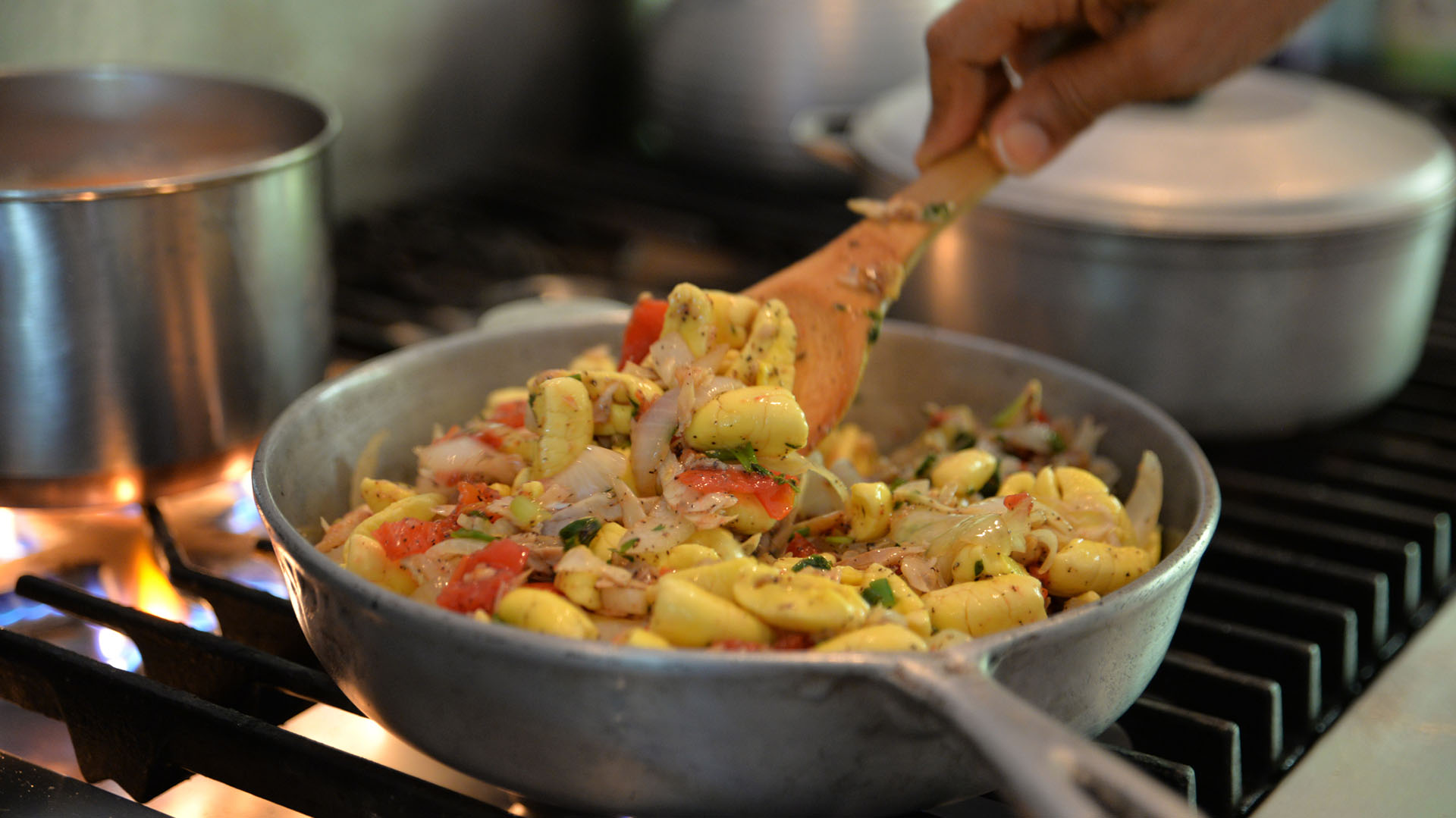Ackee And Saltfish Looks Like Scrambled Eggs, Tastes Like Jamaica
I first tasted Jamaica's national dish of ackee and saltfish on a beach in Negril. I looked at the mound of yellow fruit spiked with peppers and salted cod and I was intrigued. It looked a little like scrambled eggs, but reflected something more unexpected. Then I took a bite and it was all over: The mix of soft and firm textures, the salty and buttery flavors, swirled in my mouth and streamed directly to my heart.
Ackee and saltfish actually taste nothing like eggs. Ackee is a bland fruit that absorbs the flavors it's cooked with, which leaves the saltiness of the cod, the mix of spices, a hint of tropical essence, and a textural contrast that excites me. Decades later, it's still my favorite dish. Ackee and saltfish was served at my wedding (catered by my favorite Jamaican cook) and at my birthday celebrations, and I gobble it whenever I can locate a good version at Chicago's Jamaican restaurants. But there's nothing like savoring fresh ackee and expertly seasoned saltfish in the Jamaican sunshine. To me, the dish's flavors and bright mix of colors represent the eclectic spirit of Jamaica, but ironically, none of the ingredients originate from the island.
Ackee arrived in Jamaica during the 1700s aboard a slave ship sailing from Ghana, West Africa. The name ackee derives from akye fufu, as the fruit is known in the Twi language of Ghana. The ackee tree grows easily in the Jamaican climate. The unripe fruit, though, is poisonous, so the red skin bursting open to reveal the yellow flesh and black seeds is an important sign for when it's ready to eat. Saltfish, on the other hand, hails from Europe, where curing fish with salt was a popular preservation method developed around the same time period. It was also a cheap source of protein for enslaved Africans packed onto ships sailing the Atlantic. Both foods became staples in Jamaica, and a national dish was born. Traditionally, ackee and saltfish is served as a hearty breakfast, but it's an everyday feast that has a special place for Jamaicans.
"Ackee and saltfish is not just a tasty dish or a traditional food that we like to eat," explains Janet Crick, creative experience director for Jamaica Culinary Tours, an experiential food travel company located in Falmouth, Jamaica. "It is our national dish, so for me, it carries a much deeper symbolism. It connotes a history and a cultural legacy handed down through the ages. This is a dish born out of the sugar plantation era, and it had great significance for the survival of the enslaved people, our ancestors. So there is an unspoken, but a deep sentiment and even pride associated with the dish."

Those deep emotions seem to transmit through every bite I take of ackee and saltfish, always leaving me fulfilled and happy. That's not to say that all ackee and saltfish is made equally. The basic recipe calls for sauteed saltfish (cod), boiled ackee, onions, tomatoes, bell peppers, thyme, pimento, and the almighty Scotch bonnet pepper. People who suggest that the Scotch bonnet is optional are not to be trusted. In my opinion, it's that peppery kick that levels up the mildness of the ackee. The Scotch bonnet is also essential for most classic Jamaican dishes, including jerk, curry goat, peppered shrimp, and escoveitch fish, so it just can't be left out of the national dish.
Sadly, preparations of ackee and saltfish outside of Jamaica can sometimes result in a pepperless dish, or worse. You can find this specialty on most Jamaican restaurant menus from Brooklyn to Miami and sometimes it's great. When it's not, the common issues are improperly soaked saltfish and canned ackee, which is the only kind of ackee available in the U.S. Canned ackee, like canned anything, is no match for fresh. But if the ackee isn't overboiled and mushy and the pods are still firm, the flavors of saltfish and peppers soak into the ackee for an explosion of tastes that's enough to make you forget that it's not fresh and you're not in Jamaica. Add the necessary sides of fried plantain, festival (fried dough), and boiled green banana, and it will feel like you are indeed on the island.
That's the traditional take on ackee and saltfish, but I have also sampled modern versions, like ackee and saltfish egg rolls and even ackee and saltfish pizza whipped up by Caribbean chefs determined to introduce the delicacy to the rest of the world. "It's interesting how ackee has evolved as our Jamaican chefs have become more creative and bold in their experimentation with the fruit," said Crick. Whether I eat it heaped with peppers on a beach in Negril or topped on a fancy hors d'oeuvre at a New York gala, ackee and saltfish always tastes like love, sunshine, and Jamaica.
